Key ideas and basic models
In over four decades of studying and writing about the governance of organizations, I have developed some insights and models. A few have become part of the corporate governance rubric. I find them used in corporate governance analysis and appearing in other papers, usually without attribution! Here are some of them:
Governance is different from management
Corporate governance is different from management. Management runs the enterprise. The board or governing body ensures that it is being run well and is running in the right direction. A clear distinction needs to be drawn between the two.
The management triangle and the board circle
Management is classically depicted as a hierarchy – the triangle seen in organization charts and shown in the diagram below. The board of directors or other governing body is superimposed on management to ensure proper governance – the circle in the diagram. Board members do not form a hierarchy – all members have equal responsibilities and rights.
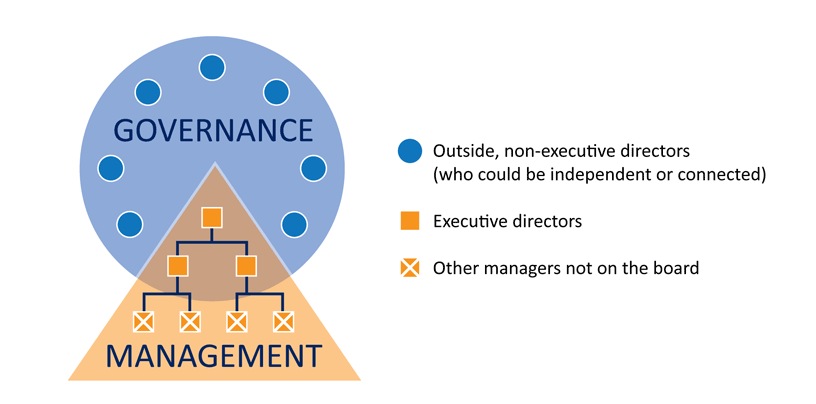
A unitary board has both outside, non-executive directors (shown as ![]() in the diagram) and executive directors (shown as a
in the diagram) and executive directors (shown as a ![]() in the diagram). Executive directors have to ‘wear two hats’ – as directors on the board and as top executives in the management hierarchy.
in the diagram). Executive directors have to ‘wear two hats’ – as directors on the board and as top executives in the management hierarchy.
Different board structures produce different power structures
The circle and triangle diagram shows the different power structures when boards have different membership structures. The options are:
1 boards composed entirely of executive directors
2 boards with a minority of outside, non-executive directors
3 boards with a majority of outside, non-executive directors
4 supervisory boards composed entirely of outside directors.
1. The all executive board
The all executive board is often found in:
• start-up and family companies where the founder is the major shareholder, the chairman of the board, and, often, the managing director or chief executive as well.
• subsidiary companies, operating in corporate groups, with strategic, planning and management control exercised by group control systems or, in an alternative approach, with the parent company devolving strategic authority to the subsidiary company board
All executive boards are often eventually supplemented by non-executive directors, because the board needs additional expertise or experience from outside the company; or in a family business on succession to the next generation, to represent family members who are not in management.
2. The majority executive board
In this concept of corporate governance, the company has a single board made up of directors in top management positions ![]() , and outside or non-executive directors
, and outside or non-executive directors ![]() . During the 20th century, the conventional wisdom in Britain was that non-executive directors could play an important role. There should be more than one, but never as many as half because, it was felt, a company should be in the hands of those who are running it.
. During the 20th century, the conventional wisdom in Britain was that non-executive directors could play an important role. There should be more than one, but never as many as half because, it was felt, a company should be in the hands of those who are running it.
The UK Hampel Committee (1998) recommended that in listed companies at least a third of the board should be non-executive. Today the corporate governance codes require more than half to be non-executive and independent.
 3. The majority non-executive board
3. The majority non-executive board
In the United States, the UK, and most other economically advanced countries the boards of listed companies normally have this board structure, so that the outside directors can wield power to ensure corporate performance and compliance.
4. The all outside director board – the two tier board
The two-tier model has two quite separate boards – the supervisory board and the management board, which respectively govern and manage the company.
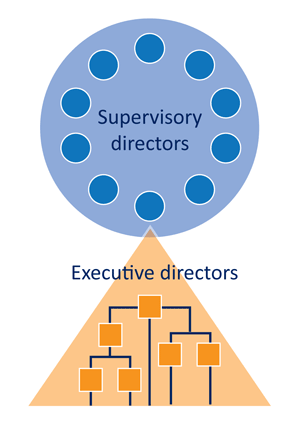 This is the basis for corporate governance in Germany, Austria and Holland and is permitted in France. Consequently this model is often called the Continental European approach to corporate governance.
This is the basis for corporate governance in Germany, Austria and Holland and is permitted in France. Consequently this model is often called the Continental European approach to corporate governance.
The supervisory board members, including the chairman, must be wholly non-executive. The members of the management board, chaired by the chief executive, are all executives of the company; in effect the top management team. Common membership of supervisory and management board is not allowed. In practice, the members of the executive board attend meetings of the supervisory board to make proposals on strategy and policy for consideration and approval. Subsequently, the supervisory board monitors progress and supervises the corporate performance. Periodically the supervisory board will meet without the executives present to evaluate their performance. The power of the supervisory board lies in its ability to hire, supervise and, if necessary, fire members of the management board.
The two-tier board format is often found in non-profit organizations, such as charities and educational institutions.
The business network model (the Japanese approach)
In Japan, major companies tend to be closely related in informal networks (keiretsu) based on inter-trading, typically with cross-holdings of shares and connected directors. Boards of public, listed companies are frequently large (30 to 35 members is not unusual). Effectively the board consists of the top four or five levels of the management organisation. Some board members might also be appointed on their retirement from other companies in the keiretsu group, occasionally from regulators. Under pressure from international investors, some companies have introduced outside directors, but some Japanese directors are still concerned that outsiders would not know enough about the company to contribute and could destroy the harmony of the board.
Independent and related non-executive directors
An important distinction needs to be drawn between independent non-executive (outside) directors and related non-executive directors. Independent non-executive directors have no relationship with the company (other than their directorship and, perhaps, an insignificant share holding) which could affect the exercise of independent and objective judgement. These are the directors required by the corporate governance codes to provide independent checks on executive management and to avoid boards being dominated by powerful executive directors. Related non-executive directors, on the other hand, though not executives of the company, have some connection with it, such as being a major shareholder, a representative of a supplier or major customer, a retired executive from that company, or a close relative of the chairman or chief executive. There may be good reasons for having them on the board, but they cannot be considered independent.
The role of the unitary board – performance and conformance
A unitary board, that is one with executive and outside directors, is responsible for both the overall performance of the enterprise and its conformance with strategies, polices and codes. In a two tier board these roles are separated.
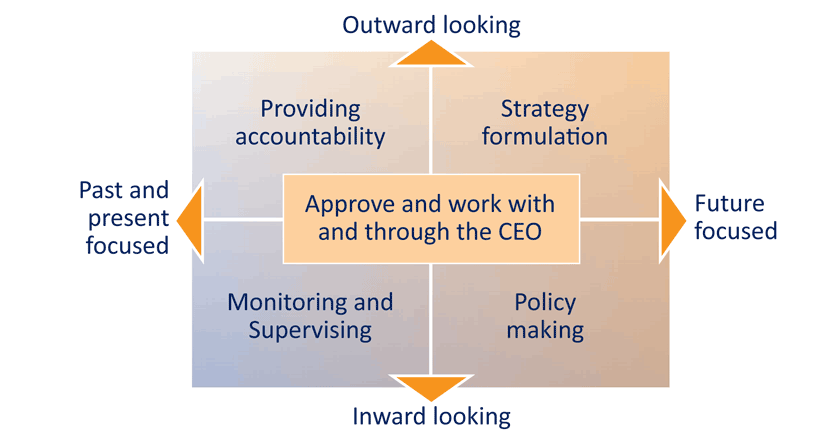
Framework for analysing board activities (Source: Hilmer F. and R.I. Tricker (1991))
The quadrant shows the board’s responsibility for formulating strategy and making significant policy decisions, approving and working with the chief executive officer. These activities contribute to the performance of the enterprise. The board is also responsible for monitoring and supervising the management of the company and providing accountability to shareholders and others, ensuring compliance with the law, stock exchange regulations, and corporate governance codes.
The scope of corporate governance
The figure shows schematically the parties involved in various perspectives on corporate governance.
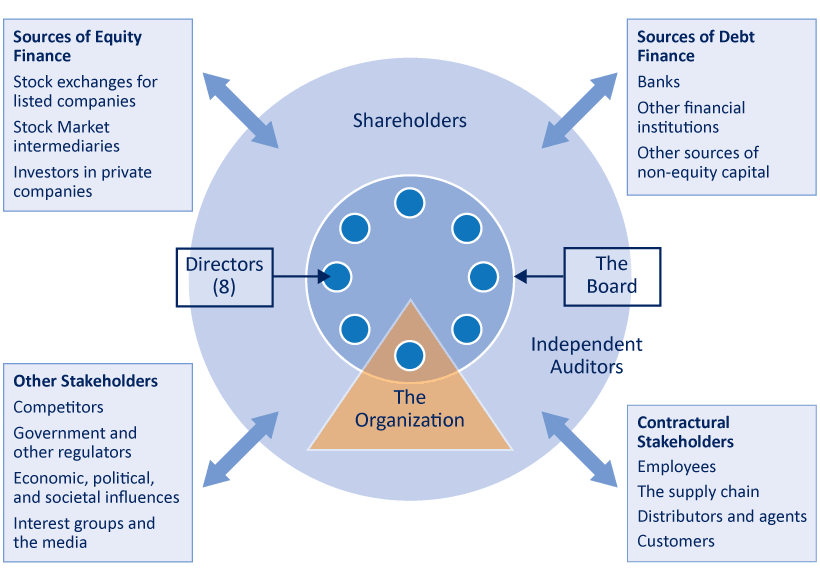
Boards have different styles of operation
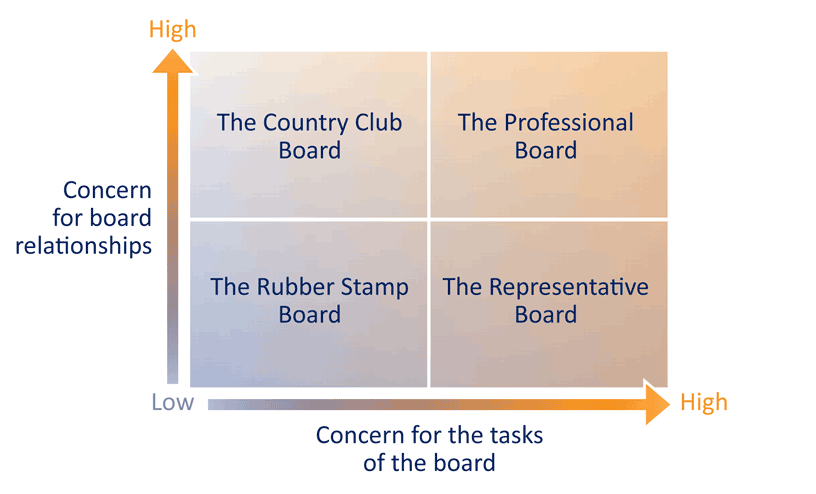
Business ethics begin in the boardroom
Business scandals and corporate collapses have brought calls for better business ethics, more training in ethics, and further regulation. But ethics in business are not just a matter of corporate citizenship, social responsibility, or sustainability: they are intrinsically part of every business decision from the boardroom, throughout management, down to basic operations. Business ethics are part of corporate governance, are a boardroom responsibility, and reflect directors’ attitudes to risk. Some boards take greater risks than others. Recognizing and managing that risk are fundamental to every board’s corporate governance responsibilities. Trust in business will not be rebuilt by more rules, regulations, or corporate governance codes, but as directors create cultures that recognize and handle ethical risk. Ultimately, the board of directors and top management are responsible for the ethical behaviour of their enterprise. Directors set the standards for their organization, provide the corporate conscience, fashion its culture, determine the risks to be taken, and set the ethical climate. They generate the value system for their organization. Business ethics begin in the board room.











